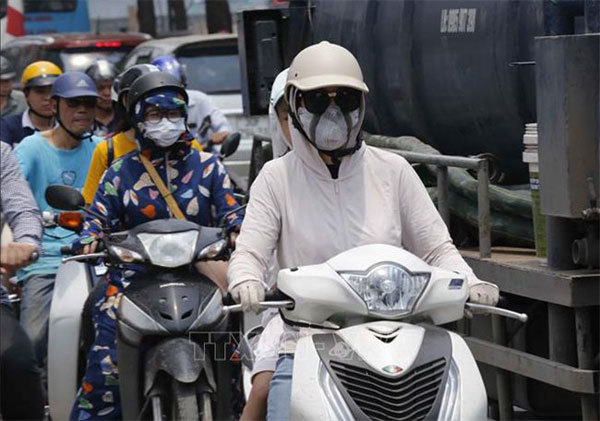 |
| Motorbike riders wear masks, sunglasses and coats to protect themselves from sunlight and the heat. - Photo: VNA |
The report by the World Bank Group and the Asian Development Bank shows that in the northern regions, average temperatures range from 22–27.5 degrees Celsius in the summer to 15–20 degrees Celsius in the winter, while the southern areas have a narrower range of 28–29 degrees Celsius in the summer and 26–27 degrees Celsius in the winter.
Greater warming has been identified in the winter months than in the summer ones. The frequency of hot days and nights has increased significantly since 1960 in every season, and the annual frequency of cold days and nights has decreased significantly.
The country is projected to experience an average temperature increase of 3.4 degrees Celsius by 2080–2100 under the highest emission pathway. This warming is slightly less than the global average projected by the Intergovernmental Panel on Climate Change’s Fifth Assessment Report of 3.7 degrees Celsius.
Across all emission scenarios and future time periods, changes in annual maximum temperatures are greater than changes in the average temperature. A study suggests that temperature increases will be strongest in southern Vietnam.
Temperature rises in Vietnam, a country already experiencing high average temperatures, are expected to lead to what might be considered chronic heat stress in some areas. The study highlights both Hanoi and HCMC among the urban areas most threatened by deadly heat globally.
According to the report, labor productivity during the peak months has already dropped by 10% as a result of warming and a decline of up to 20% might be expected by 2050. Research focused on laborers in Danang City has shown the high likelihood that by 2050, temperatures will regularly exceed thermal comfort levels set by the Vietnamese Ministry of Health, an issue which is likely to impact several million laborers in agriculture and other industries around Vietnam.
In combination, it is highly likely that the above processes will have a considerable impact on national food consumption patterns both through direct impacts on internal agricultural operations and through impacts on the global supply chain.
Research has established a reasonably well constrained relationship between heat stress and labor productivity, household consumption patterns and household living standards.
In general terms, the impact of an increase in temperature on these indicators depends on whether the temperature rise moves the ambient temperature closer to, or further away from, the optimum temperature range.
The optimum range can vary depending on local conditions and adaptations but with a monthly average maximum temperature of 28 degrees Celsius, it is inevitable that increases in temperature will have a negative influence on outdoor thermal comfort and hence labor productivity and health in Vietnam. The Vietnam Ministry of Health sets a threshold of 28 degrees Celsius as a maximum for safe heavy labor.
Heavy manual labor jobs are commonly among the lowest paid while also being most at risk of productivity losses due to heat stress. Poorer businesses are least able to afford air conditioning, and poorer farmers and communities are least able to afford local water storage, irrigation infrastructure and farming technologies which assist in adaptation.
On average, a one degree increase in ambient temperature can result in a 0.5–8.5% increase in electricity demand. This increase in demand places a strain on energy generation systems, compounded by the heat stress on the energy generation system itself, commonly due to its own cooling requirements, which can reduce its efficiency.
SGT

Prolonged hot weather causes health issues for Vietnamese people
Prolonged hot weather with average temperatures of about 40 degree Celsius across the country in recent days have led to health problems.

Hundreds of temperature records broken over summer
Nearly 400 all-time high temperature records were broken over the summer.